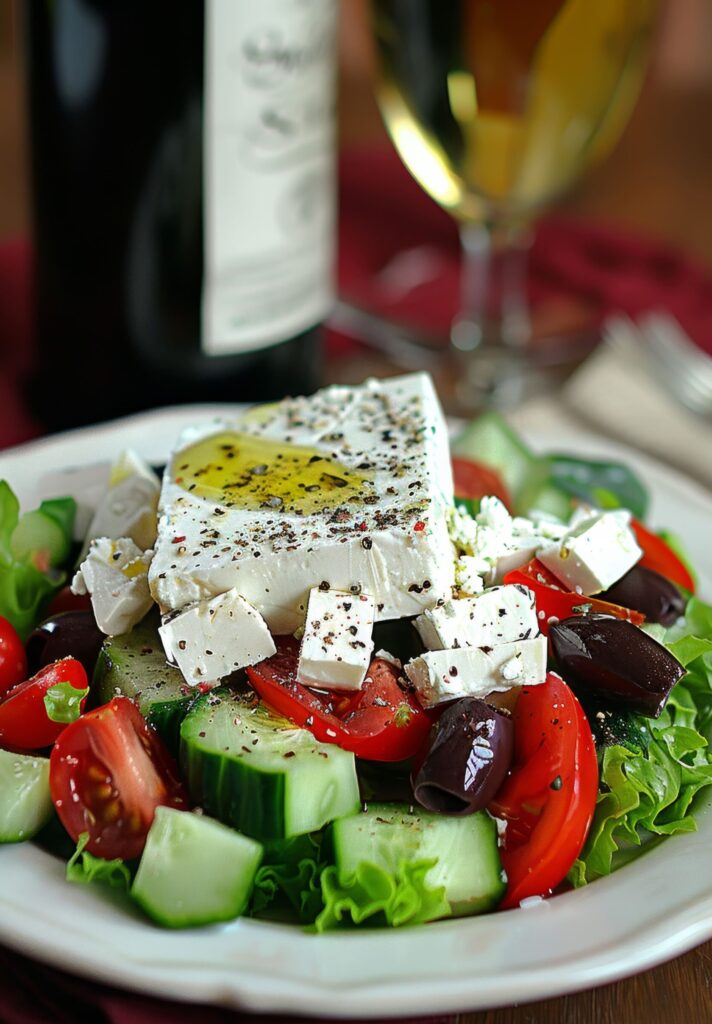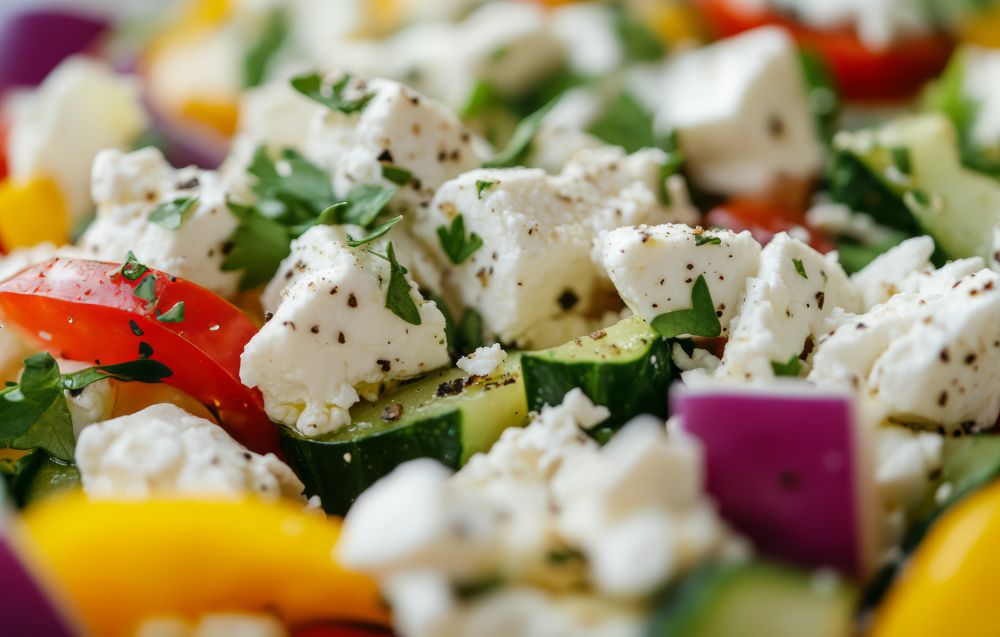Feta cheese. The very name might make your mouth water! Known for its tangy flavor and crumbly texture, this Greek culinary treasure elevates almost any dish it touches. But how much do we really know about its nutritional value? Packed with flavor and nutrients, feta cheese is a favorite worldwide, but there’s more to it than meets the eye. Curious about feta cheese nutrition, its health benefits, and how to enjoy it responsibly without overindulging? You’re in the right place. Dive in to discover what makes this Mediterranean staple a flavorful, nutritious, and versatile addition to your meals!
Introduction to Feta Cheese
What is Feta Cheese?
Feta cheese is one of those foods that feels fancy but is surprisingly accessible. Originating in Greece, it’s a type of brined cheese traditionally made from sheep’s milk or a mixture of sheep’s and goat’s milk. Its unique tangy flavor and crumbly texture make it a standout in dishes from salads to pastries. And yes, it’s as versatile as it is delicious.
Origins and History of Feta Cheese
Did you know that feta cheese has been around for thousands of years? The earliest references to something resembling feta date back to ancient Greece. According to myths, even the gods on Mount Olympus couldn’t resist its allure. Today, it’s officially recognized as a Protected Designation of Origin (PDO) product, meaning authentic feta must be made in Greece using traditional methods.
Popularity and Uses Across the Globe
While feta is Greek in origin, it has won hearts all over the world. From Greek salads and spanakopita to innovative dishes like watermelon and feta skewers, this cheese has found a permanent spot in many kitchens. And let’s be honest, isn’t everything better with a sprinkle of feta on top? For inspiration, pair it with a Mediterranean dish like Salmon Bowls for Balanced Meals to take your meal game to the next level.
Nutritional Profile of Feta Cheese
Macronutrient Breakdown (Proteins, Fats, Carbohydrates)
So, what’s actually in feta cheese? For starters, it’s a nutrient powerhouse in a small package. In just one ounce (28 grams), you’re looking at around:
- Protein: 4 grams – great for building and repairing tissues.
- Fat: 6 grams – mostly healthy fats, but watch your portions.
- Carbohydrates: Less than 1 gram – keto lovers, rejoice!
If you love breaking down nutrition info, you might also enjoy the Granola Bar Nutrition Facts Guide to compare other health-conscious snacks.
Vitamins and Minerals in Feta Cheese
Feta isn’t just about protein and fat; it’s also loaded with important vitamins and minerals. For example:
- Calcium: Your bones’ best friend. One ounce provides about 14% of your daily calcium needs.
- Phosphorus: Another bone-health hero.
- Vitamin B12: Essential for brain function and energy levels.
What about pairing feta with something delicious and carb-friendly? It’s perfect on Artisan Italian Bread for a Mediterranean-inspired snack.
Blockquote:
“Feta cheese is more than just a topping; it’s a nutrient-packed addition to your meals that combines health and flavor in every bite.”
Calorie Content and Serving Sizes
Feta cheese is a food that feels fancy yet remains surprisingly accessible. This iconic cheese hails from Greece and is traditionally made using sheep’s milk or a mix of sheep’s and goat’s milk. Its tangy flavor and crumbly texture make it a standout ingredient in a variety of dishes, from refreshing salads to savory pastries. The brining process gives feta its distinct salty tang, enhancing its versatility in cooking. Whether crumbled over roasted vegetables, used as a topping for Mediterranean-inspired pizzas, or baked into rich spanakopita, feta adds a unique depth of flavor to every meal, making it truly irresistible.

Health Benefits of Feta Cheese
Bone Health and Calcium Content
Do you ever think about your bones when you’re eating? Probably not, but maybe you should. Feta cheese is a fantastic source of calcium, a mineral crucial for maintaining strong bones and teeth. Pair it with Hawaiian Roll French Toast for a quick and satisfying snack that’s as wholesome as it is delicious.
Probiotics and Gut Health
Gut health is all the rage these days, and for a good reason—it impacts everything from digestion to mental health. Feta cheese, being a brined and fermented product, is naturally rich in probiotics. These friendly bacteria can improve your digestion and even strengthen your immune system. Isn’t it amazing how cheese can do that?
And if you’re exploring how to make healthier snack choices, don’t miss the Vegan Snacks Made Simple for more inspiration to balance your diet.
Source of High-Quality Protein
Let’s not overlook protein—the essential building block of life. Feta cheese, with its impressive protein content, is a fantastic choice for vegetarians aiming to boost their intake. It’s a delicious way to add nutritional value to meals, whether crumbled over a crisp salad or sprinkled on roasted vegetables. Beyond its tangy flavor, feta contributes vital protein that helps repair tissues and maintain muscle health. This versatile cheese doesn’t just enhance your dishes; it also provides the fuel your body needs to thrive. With feta, you can enjoy both flavor and function in every bite.
Blockquote:
“Adding feta to your diet isn’t just about taste—it’s a step toward better gut health, stronger bones, and a more balanced diet overall.”
For more inspiration, check out tips about What Is The Best Bread For French
Common Nutritional Concerns of Feta Cheese
Feta cheese might be a beloved staple in many kitchens, but let’s face it—no food is perfect. Like everything else, feta has its quirks that deserve attention. Don’t worry, though. We’re here to address these common concerns so you can enjoy your feta guilt-free (or at least with a little more knowledge).
Sodium Content – How Much is Too Much?
One of the most frequently discussed downsides of feta cheese is its high sodium content. As a brined cheese, it packs about 312 mg of sodium per ounce, which is roughly 13% of the recommended daily intake for most adults.
Why so much salt? The brine isn’t just for flavor—it acts as a preservative, keeping the cheese fresh and giving it that signature tang. But if you’re watching your sodium intake, you’ll want to keep portions small or rinse the cheese under water to reduce the saltiness.
According to the USDA’s official feta cheese nutritional facts, sodium is one of the standout components in feta’s nutrient profile, so it’s worth keeping tabs on.
Lactose Intolerance and Feta Cheese
Here’s some good news for the lactose-intolerant crowd: feta cheese contains less lactose than many other dairy products, especially when made with sheep’s or goat’s milk. The fermentation process used in making feta breaks down much of the lactose, making it easier to digest for those who are lactose-sensitive.
That said, it’s not completely lactose-free, so those with severe lactose intolerance should proceed with caution.
Fat Content and Weight Management
Feta is often celebrated for its creamy texture, but that creaminess comes with a cost: fat content. Each ounce of feta contains about 6 grams of fat, with 4 grams being saturated fat. While that might sound high, remember that fat isn’t the enemy—it’s about balance.
Moderation is key. Pairing feta with fresh vegetables or whole grains can make it part of a balanced meal rather than a calorie bomb.
Comparing Feta Cheese to Other Cheeses
Ever wonder how feta stacks up against other popular cheeses? It’s a valid question, especially if you’re trying to make healthier choices or diversify your meals. Let’s break it down:
Feta vs. Cottage Cheese
Cottage cheese is often seen as a “diet-friendly” option, and for a good reason—it’s lower in calories and fat than feta. However, feta holds its own in terms of flavor and nutrients. While cottage cheese provides more protein (about 14 grams per half-cup compared to feta’s 4 grams per ounce), feta shines in its calcium and probiotic content.
If you’re looking for something light and versatile, cottage cheese might be the way to go. But if flavor and cultural flair are your priorities, feta wins hands down.
Feta vs. Goat Cheese
Feta and goat cheese are often used interchangeably in recipes, but they’re not identical twins. Feta has a sharper, tangier flavor, while goat cheese is creamier and milder. Nutritionally, goat cheese is slightly lower in sodium and calories, making it a good alternative for those watching their salt intake.
However, feta edges out goat cheese in probiotic content due to its fermentation process. If gut health is a priority, feta is your go-to.
Feta vs. Mozzarella and Cheddar
Mozzarella and cheddar are household staples, but how do they compare to feta?
- Mozzarella: Lower in sodium and fat, mozzarella is milder in flavor and melts beautifully. It’s ideal for pizzas and pasta but doesn’t offer the same tangy punch as feta.
- Cheddar: Aged cheddar contains more fat and calories than feta but also offers a stronger flavor profile. However, it lacks the probiotics that make feta a standout in gut health.
Health Benefits of Feta Compared to Other Cheeses
When choosing between feta and its competitors, it’s essential to consider your health goals:
- Bone Health: Thanks to its high calcium content, feta is a top choice for supporting strong bones. Check out the Ranking cheeses by healthfulness for more information and bone health.
- Gut Health: The fermentation process gives feta a probiotic boost, which can benefit digestion and immunity.
- Weight Management: While feta isn’t the lowest-calorie option, its intense flavor means you can use less without compromising on taste.
Incorporating Feta Cheese into a Balanced Diet
If you’ve ever opened a block of feta cheese and wondered, “How can I use this beyond salads?” you’re in for a treat. Feta is incredibly versatile, and its tangy flavor can enhance everything from snacks to full-blown meals. Let’s explore creative, balanced ways to enjoy this delicious cheese.
Pairing Feta with Vegetables and Fruits
One of the simplest and healthiest ways to enjoy feta is by pairing it with fresh produce. Vegetables like spinach, cucumbers, and bell peppers complement feta’s tangy profile beautifully. A classic example is a Greek salad, where feta steals the show alongside crisp veggies and olives.
But don’t stop at veggies—feta and fruit are a match made in heaven. Think watermelon and feta skewers for a refreshing summer snack, or crumble feta over a warm roasted pear for a sweet-and-savory dessert. The cheese’s saltiness balances the natural sweetness of fruits, making every bite exciting.
Feta in Mediterranean Diet Recipes
The Mediterranean diet is celebrated for its health benefits, and feta is a cornerstone of this lifestyle. Dishes like spanakopita (spinach and feta pastry) or baked feta with tomatoes and olive oil are bursting with flavor and nutrients. These recipes make it easy to incorporate feta without overloading on calories or fat.
For a quick and satisfying breakfast, try avocado toast topped with crumbled feta and a sprinkle of red pepper flakes. It’s creamy, tangy, and provides a healthy mix of fats and protein to kick-start your day.
Creative and Healthy Feta-Based Meal Ideas
Feta’s crumbly texture and bold flavor make it a fantastic addition to many meals. Here are a few ideas:
- Feta-Stuffed Bell Peppers: Hollow out bell peppers, fill them with a mixture of feta, quinoa, and spinach, and bake until tender.
- Feta-Topped Soups: Add a sprinkle of feta to tomato soup or lentil stew for a tangy twist.
- Grilled Feta Sandwiches: Swap out your usual cheese for feta in a grilled sandwich. Pair it with roasted vegetables for a Mediterranean-inspired lunch.
The beauty of feta is that a little goes a long way. Its intense flavor means you can use less cheese while still creating a satisfying dish.
Tips for Storing Feta Cheese Properly
Like any dairy product, feta requires proper storage to maintain its flavor and texture. Here’s how to ensure your feta stays fresh and delicious.
Storing Feta in Brine
If you purchase feta in a brine solution, keep it there. The brine acts as a natural preservative, preventing the cheese from drying out and losing its flavor. If the brine gets low or cloudy, you can make your own using a mixture of water and salt.
- Pro Tip: Use a glass container with a tight lid to keep the brine and feta fresh.
Storing Feta Without Brine
If your feta doesn’t come in brine or you’ve already discarded it, don’t worry. Wrap the cheese in wax paper or parchment paper, then place it in an airtight container. Avoid using plastic wrap directly on the cheese, as it can trap moisture and cause spoilage.
- Pro Tip: Add a sprinkle of olive oil to the container to keep the cheese moist and enhance its flavor.
Can You Freeze Feta Cheese?
Yes, you can freeze feta cheese, but it’s best reserved for cooking purposes. Freezing can alter the texture, making it crumbly and slightly grainy. To freeze feta, wrap it tightly in plastic wrap and store it in an airtight freezer bag. Thaw in the refrigerator before using, and incorporate it into dishes like casseroles or baked pastas.
Most Common Problems and Solutions Related to Feta Cheese
How to Tell if Feta Has Gone Bad
One of the most common concerns with feta is spoilage. So, how do you know if your cheese is past its prime? Look for:
- Mold: While some cheeses are mold-friendly, feta is not. Discard it if you see any.
- Texture Changes: Fresh feta should be crumbly but moist. If it feels slimy or excessively dry, it’s likely gone bad.
- Smell: A sour or unpleasant odor is a surefire sign your feta isn’t safe to eat.
Avoiding Feta Cheese Spoilage
To extend the shelf life of your feta, follow these simple tips:
- Store it in the coldest part of your fridge (usually the back).
- Always use clean utensils to remove the cheese, preventing cross-contamination.
- Keep it covered to avoid exposure to air, which can dry it out.
Finding High-Quality Feta Cheese in Stores
Not all feta is created equal. When shopping, look for feta that’s labeled as a Protected Designation of Origin (PDO) product, meaning it’s made in Greece using traditional methods. Authentic feta is typically made from sheep’s milk or a mixture of sheep’s and goat’s milk.
If PDO feta isn’t available, look for feta that’s stored in brine, as it tends to be fresher and more flavorful. Avoid pre-crumbled feta if possible—it often contains anti-caking agents that can affect the texture.
Why Feta Cheese Stands Out
What makes feta cheese so special? Its unique flavor, nutritional profile, and versatility make it a standout choice for those who love good food and care about their health. Whether you’re crumbling it over a salad or using it as a filling for a savory pastry, feta adds depth and character to any dish.
Feta cheese is more than just a culinary delight—it’s a connection to history, culture, and the Mediterranean way of life. Its balance of flavor and nutrition makes it a cheese worth celebrating, and with the right care and creativity, it can become a staple in your kitchen.

